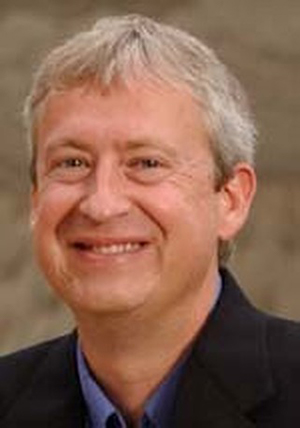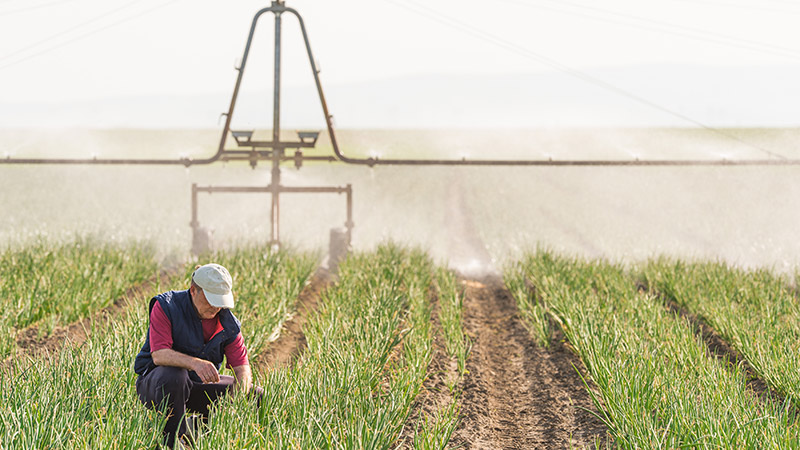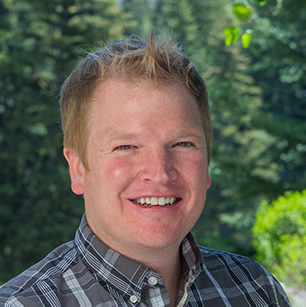September 18, 2019
Agriculture is the largest user of water in Colorado, but as Colorado’s cities and suburbs have grown, municipal water managers in need of more water for new residents have increasingly looked to farmers and ranchers for supplies. For many decades, municipalities have purchased agricultural water rights and transferred those rights from rural communities to urban areas. This is known as “buy-and-dry” as it permanently removes those farmers’ lands from agricultural production. If Colorado continues down this path, as much as one-third of the irrigated land in the South Platte River Basin alone could be lost by 2050. The loss of agriculture can have a significant economic and social impact in rural communities, and stakeholders are working to identify alternatives to buy-and-dry transactions that will help supply growing cities with water without permanently affecting farms and ranches and rural communities.
In March of this year, Doug Kenney, Director of the Western Water Policy Program at the University of Colorado Law School, and colleagues published a new paper in the journal Water Security, which examined several of those alternatives to buy-and-dry, known collectively as “alternative transfer methods” (ATMs). The goal of the paper was to better understand the history and context for ATMs in Colorado, examine their pros and cons, and consider how they may play a role in managing water in Colorado, especially as water becomes more scarce in a changing climate.
WRA’s John Berggren (Water Policy Analyst and co-author on the article) recently sat down with Doug Kenney to discuss the article and its findings. Below is that interview.
John Berggren: What are Alternative Transfer Methods, and why are people interested in using them in Colorado?
Kenney: Alternative Transfer Methods, almost always referred to as ATMs, is a term used to describe a variety of water sharing agreements, but in most cases, it involves a farmer conserving water through fallowing, with the saved water being used by a city that compensates the farmer for their expenses and lost revenues associated with fallowing otherwise productive land. It’s the “A” in ATM that is key; it is an alternative to a farmer simply selling off water rights to a city, which leads to the so-called “buy-and-dry” outcome that can result in huge economic and social impacts in rural areas.
John Berggren: How long have people in Colorado been exploring Alternative Transfer Methods and what are some specific examples?
Kenney: ATMs are still relatively new in Colorado (other Western states are also experimenting with these methods, although the term “ATM” is primarily used in Colorado). Much of the recent experimentation with ATMs in Colorado was done as part of the System Conservation Pilot Program from 2015-2017. The program was an effort to explore the viability of using ATMs to enhance reservoir storage in the Colorado River Basin. Several farmers from the Grand Valley Project in Grand Junction participated in those efforts. Colorado is currently exploring possible pathways for expanding on this work, which is supported by the new Drought Contingency Plan for the Colorado River [more on that below].
John Berggren: What are some of the main hurdles to more widespread adoption of Alternative Transfer Methods? And has there been any progress in recent years?
Kenney: For the most part in Colorado, people are apprehensive to enter into any agreement that might affect the value or legal ownership of their water right. Any water rights transfer in Colorado needs to be approved by a water court. And for a water right transfer to be considered by a water court, there needs to be an engineering evaluation to consider past and present consumptive use, and there are often time legal fees associated with the transaction.
These challenges are magnified in an ATM, as some farming activity is still ongoing, which makes calculating changes in consumptive use particularly difficult. Additionally, unlike a traditional water transfer, the farmer in an ATM is looking to retain legal ownership of water temporarily leased, raising concerns with the use-it-or-lose-it orientation of Colorado water law (i.e., prior appropriation). In short, an ATM is frequently more difficult and more expensive (on a per acre-foot basis) to implement than a traditional buy-and-dry transaction, so absent a compelling reason to do so, it is often not the preferred choice of either the buyer or seller.
What is consumptive use?
Water use is divided into two broad categories: consumptive use and non-consumptive use. When water is consumptively used, that water is taken out of the river or reservoirs and is no longer available to other users in the system. When water is non-consumptively used, that water is returned to the system and available for downstream users.
What is prior appropriation?
Prior appropriation is a water law system developed in the American West that establishes water rights based on the year in which a specific amount of water was first put to beneficial use (also known as “first-in-time, first-in-right”). The earlier the first beneficial use occurred, the more “senior” that water right becomes. During times of scarcity, “junior” water rights can be curtailed to ensure that “senior” water rights received their full allocations. In other words, the system dictates that whichever water use began first, is the first in line when there is not enough water to meet all of the established beneficial uses.
John Berggren: Much of the conversation regarding Alternative Transfer Methods is focused on agriculture-to-urban transfers. Are there other opportunities for ATMs (e.g., farmer-to-farmer)?
Kenney: While the ag-to-urban characterization of ATMs is generally accurate, some arrangements have involved industrial interests (such as energy producers) and groups seeking water for environmental benefits. Farmer-to-farmer arrangements also can make a lot of sense, particularly for those irrigating along the same stream or ditch. Ultimately, anytime there are two parties who value water differently, or who have significantly different tolerances for water shortage, then a potential exists to share water in creative ways – if the hurdles mentioned earlier are not prohibitive.
John Berggren: In general, what does the agricultural community think about Alternative Transfer Methods? What about municipalities?
Kenney: I’m fond of saying that ATMs are often nobody’s first choice, and that is perhaps the biggest obstacle to their widespread adoption. In rural areas, the first choice of the community is usually to see all water remain in the area, maximizing agricultural production. An ATM is certainly better for the community than a permanent buy-and-dry transfer, but it’s not ideal. Likewise, while cities are sympathetic to the socioeconomic impacts that buy-and-dry can have on rural areas, the fact remains that a permanent, one-time transaction of buy-and-dry is often a cheaper and easier way to shore up urban water supply reliability. Finally, environmentalists and other public interest groups generally think that the focus of water policy reform should be on conservation, not on creatively shifting supplies in a way that further fuels sprawl and urban consumption.
John Berggren: Most everyone agrees that ATMs need to be voluntary, temporary, and compensated in order to be successful. You’ve discussed the temporary component, but can you discuss why ATMs also need to be voluntary and compensated? What are some of the benefits to farmers in participating in ATMs?
Kenney: Within policy circles, ATMs are usually described as tools for water “sharing,” but make no mistake, these are market transactions where participation is voluntary, and an exchange of goods (water) for money is essential. And like other market transactions, nobody comes to the table unless their economic calculation concludes that participation is better than not participating. As a farmer, an ATM allows you to utilize your water supply as a cash crop – a crop that doesn’t require an effort to grow or harvest, and one that is immune to weather or market conditions that may be unfavorable for agriculture. As the holders of most water rights and the consumers of most water, farmers understand they have a key role to play in solving water issues in the region. ATMs can be a tool for doing that.
John Berggren: Earlier this year, the Colorado River Basin states and Bureau of Reclamation agreed to the Drought Contingency Plans (DCPs) to reduce shortage risks in both the Upper and Lower Basin. Now there are questions about how to effectively carry out the Upper Basin DCP. Do ATMs factor into those Upper Basin DCP discussions currently happening?
Kenney: The Drought Contingency Plan (DCP) provides a mechanism for Colorado and the other Upper Basin states to store conserved water in Lake Powell. But, just as opening a new bank account doesn’t necessarily translate to having more money, this new feature of the DCP only provides a place to store water should the Upper Basin follow through and build demand management programs that cut back on water consumption, creating this water. Whether or not Colorado wants to do this remains a bit of an open question. Conceptually, a program based on voluntary and compensated participation has broad support, but only if such a program is not used as a stepping stone to one that loses either of those twin pillars (voluntary and compensated). Presumably, these concerns can be worked out at the bargaining table, but it’s not likely to be an easy process.
John Berggren: Colorado has set a goal to have 50,000 acre-feet of water shared through ATMs by 2030. Where do you see this goal fitting in the larger picture of the state’s water planning?
Kenney: When it comes to ATMs, I’m inclined to adopt the “go big or go home” philosophy. It will take (and is taking) a significant amount of effort and experimentation to push these mechanisms into the mainstream, and that’s probably not worth doing if ATMs are going to simply be a way to shift 50,000 acre-feet of demand. At the state level, especially the state as it will appear in 2030, that hardly moves the needle. Of course, saying this likely makes ATMs scarier for some parties, but it’s the failure to use ATMs in a big way that is truly frightening, as economic and political pressures will continue to drive water out of agriculture as Colorado becomes increasingly urbanized. I believe ATMs are the best hope for meeting new demand in a way that is limited and that doesn’t leave rural Colorado behind. If there is one party that desperately needs ATMs to succeed, it is the rural communities – not the farmers necessarily, but the businesses and towns that are completely reliant on the economic engine of agricultural production. These are the true victims of buy-and-dry, and these are the people who don’t have a place at the negotiating table when water rights are bought and sold. I think this is the constituency that needs to embrace and fight for ATMs, but I realize that can seem counterintuitive. The title of our ATM article reflects this quandary, as we ask if ATMs are a “Savoir of rural landscapes or Solomon’s choice?”
John Berggren: Thanks so much for taking the time to chat today, and for sharing your insights on ATMs in Colorado.

Doug Kenney
Director, Western Water Policy Program, University of Colorado Law School, Getches-Wilkinson Center for Natural Resources, Energy and the Environment
Dr. Kenney researches and writes extensively on several water-related issues, including law and policy reform, river basin and watershed-level planning, climate change adaptation, and water resource economics, and is the founder of the Colorado River Governance Initiative. He has served as a consultant to a variety of local, state, multi-state, and federal agencies, including several Interior Department agencies, EPA, the US Forest Service, and special commissions (e.g., the Western Water Policy Review Advisory Commission); and national governments and NGOs in Asia and Africa. Additionally, he has made presentations in 20 states (and the District of Columbia), 7 nations, and 4 continents. He has a B.A. in biology from the University of Colorado, a M.S. in Natural Resources Policy and Administration from the University of Michigan, and a Ph.D. in Renewable Natural Resource Studies from the University of Arizona.
Learn more about the published paper:
Abstract
This article focuses on the emerging landscape for Alternative Transfer Methods (ATMs) in Colorado, USA. ATMs are developing within a legal landscape of waterrights governed by prior appropriation law, growing demand for water in urban centers driven by population growth, and an aging rural farm population whose mostvaluable asset may include senior water rights. Rural-urban water transfers in the past have been linked to the collapse of rural economies if pursued to the extremeextent of“buy-and-dry,”where water rights were purchased outright and permanently removed from agricultural land (e.g. Crowley County). This article focuses onthe emerging innovations of ATMs, which seek to accomplish the same purpose of providing additional water to growing cities but through moreflexible me-chanisms, such as rotational fallowing, interruptible supplies, and water banks, that aim to preserve rural economies as well. We review the history and context forwater allocation in Colorado, the history of rural-urban transfers, and focus on ATMs and their pros and cons. We conclude with implications of ATMs for watergovernance and providingflexibility and sustainability in a changing climate.



